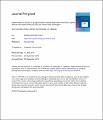| dc.contributor.author | Kulomäki, Suvi | |
| dc.contributor.author | Lahtinen, Elmeri | |
| dc.contributor.author | Perämäki, Siiri | |
| dc.contributor.author | Väisänen, Ari | |
| dc.date.accessioned | 2019-11-08T10:51:08Z | |
| dc.date.available | 2019-11-08T10:51:08Z | |
| dc.date.issued | 2019 | |
| dc.identifier.citation | Kulomäki, S., Lahtinen, E., Perämäki, S., & Väisänen, A. (2019). Determination of mercury at picogram level in natural waters with inductively coupled plasma mass spectrometry by using 3D printed metal scavengers. <i>Analytica Chimica Acta</i>, <i>1092</i>, 24-31. <a href="https://doi.org/10.1016/j.aca.2019.09.075" target="_blank">https://doi.org/10.1016/j.aca.2019.09.075</a> | |
| dc.identifier.other | CONVID_33253282 | |
| dc.identifier.uri | https://jyx.jyu.fi/handle/123456789/66270 | |
| dc.description.abstract | The determination of ultra-trace concentrations of Hg in natural water samples via preconcentration using 3D printed metal scavenger technique followed by inductively coupled plasma mass spectrometry (ICP-MS) was developed. The determination of Hg in certified reference material ERM-CA615 (groundwater) was performed with high accuracy and precision resulting in recovery of 100 ± 3% and RSD <2.5%, respectively. Selective laser sintering (SLS) 3D printing was used to fabricate the scavengers using a mixture of polyamide-12 powder with thiol-functionalized silica. The preconcentration procedure is based on the adsorption of Hg on the scavenger and followed by elution of the preconcentrated Hg from the filter with 0.3% thiourea in 8% HCl prior to its determination by ICP-MS. A preconcentration factor of 92.8 can be achieved by filtering 495 mL of water followed with the elution step. Very low instrumental detection limit and method detection limit were obtained resulting in 0.013 and 0.037 ng L−1, respectively. The method was applied successfully for the determination of Hg in different lake and river water samples. The developed method is the first preconcentration method enabling simple and accurate determination of Hg in pg L−1 concentrations in natural waters with ICP-MS. | en |
| dc.format.mimetype | application/pdf | |
| dc.language | eng | |
| dc.language.iso | eng | |
| dc.publisher | Elsevier | |
| dc.relation.ispartofseries | Analytica Chimica Acta | |
| dc.rights | CC BY-NC-ND 4.0 | |
| dc.subject.other | mercury | |
| dc.subject.other | inductively coupled plasma mass spectrometry | |
| dc.subject.other | ultra-trace concentration | |
| dc.subject.other | preconcentration | |
| dc.subject.other | 3D printing | |
| dc.subject.other | natural water | |
| dc.title | Determination of mercury at picogram level in natural waters with inductively coupled plasma mass spectrometry by using 3D printed metal scavengers | |
| dc.type | article | |
| dc.identifier.urn | URN:NBN:fi:jyu-201911084788 | |
| dc.contributor.laitos | Kemian laitos | fi |
| dc.contributor.laitos | Department of Chemistry | en |
| dc.contributor.oppiaine | Epäorgaaninen ja analyyttinen kemia | fi |
| dc.contributor.oppiaine | Uusiutuvat luonnonvarat ja elinympäristön kemia | fi |
| dc.contributor.oppiaine | Inorganic and Analytical Chemistry | en |
| dc.contributor.oppiaine | Renewable Natural Resources and Living Environment | en |
| dc.type.uri | http://purl.org/eprint/type/JournalArticle | |
| dc.type.coar | http://purl.org/coar/resource_type/c_2df8fbb1 | |
| dc.description.reviewstatus | peerReviewed | |
| dc.format.pagerange | 24-31 | |
| dc.relation.issn | 0003-2670 | |
| dc.relation.volume | 1092 | |
| dc.type.version | acceptedVersion | |
| dc.rights.copyright | ©2019 Elsevier B.V. | |
| dc.rights.accesslevel | openAccess | fi |
| dc.relation.grantnumber | | |
| dc.subject.yso | 3D-tulostus | |
| dc.subject.yso | elohopea | |
| dc.subject.yso | vesi | |
| dc.subject.yso | vesistöt | |
| dc.subject.yso | spektrometria | |
| dc.subject.yso | haitalliset aineet | |
| dc.format.content | fulltext | |
| jyx.subject.uri | http://www.yso.fi/onto/yso/p27475 | |
| jyx.subject.uri | http://www.yso.fi/onto/yso/p14245 | |
| jyx.subject.uri | http://www.yso.fi/onto/yso/p3792 | |
| jyx.subject.uri | http://www.yso.fi/onto/yso/p1157 | |
| jyx.subject.uri | http://www.yso.fi/onto/yso/p10177 | |
| jyx.subject.uri | http://www.yso.fi/onto/yso/p7067 | |
| dc.rights.url | https://creativecommons.org/licenses/by-nc-nd/4.0/ | |
| dc.relation.doi | 10.1016/j.aca.2019.09.075 | |
| dc.relation.funder | Jenny ja Antti Wihurin rahasto | fi |
| dc.relation.funder | Jenny and Antti Wihuri Foundation | en |
| jyx.fundinginformation | Financially support from the Jenny and Antti Wihuri Foundation is greatly appreciated. The research was also supported by the Department of Chemistry, University of Jyväskylä and by the Technology Industries of Finland Centennial Foundation as a part of The Future Makers program. The authors would like to thank Matti Leppänen and Heidi Ahkola from Finnish Environment Institute (SYKE) for water samples, Virva Kinnunen, for advice regarding the use of ICP-MS and for water samples and Dr. Kimmo Kinnunen for the HIM imaging. | |
| dc.type.okm | A1 | |

